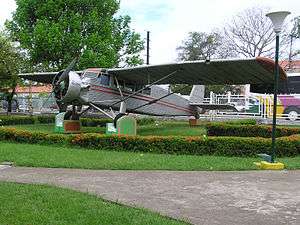Metal Aircraft Corporation Flamingo
The Metal Aircraft Corp. Flamingo was a monoplane produced in Cincinnati, Ohio by the Metal Aircraft Corporation in the 1930s.[1]
| Flamingo | |
|---|---|
 | |
| G-2-W Flamingo El Rio Caroní, on display at Ciudad Bolívar airport, in Venezuela | |
| Role | Passenger monoplane |
| National origin | United States of America |
| Manufacturer | Metal Aircraft Corporation |
| Designer | Ralph R. Graichen |
| First flight | 8 April 1928 |
| Status | Retired |
| Number built | 21 |
| Unit cost |
around $23,000 in 1929 |
Design and development
The Metal Aircraft Corporation purchased the design from the Halpin Development Co. and unveiled it at the 1929 National Air Races with Elinor Smith.[2][3] Following an accident at Bowman Field in May 1928, the prototype Flamingo was redesigned with a different nose, windscreen, and tail.[4]
Operational history
One G-2-W, named El Rio Caroní, is best remembered for its role in the discovery of Angel Falls by Jimmy Angel in 1935. Although well known to the local indigenous population, the falls had been glimpsed only by European explorers until Jimmy Angel crash-landed while attempting to land above the falls on Auyán-tepui during gold exploration.
The Metal Aircraft Corporation Flamingo that crashed above the falls was recovered by helicopter in the 1960s by the Venezuelan government and is on display at the entrance of the Ciudad Bolívar airport, in Venezuela. A replica was put in its place for visitors of the crash site.[5]
Other operators included the Mason & Dixon airline.[2]
Variants

- Halpin Flamingo
- six-passenger 410hp P&W[6]
- G-1
- five-passenger 450hp P&W
- G-2
- six-passenger
- G-2-H
- six-passenger 525hp P&W

Specifications (Flamingo G-2-W)
Data from Skyways, Air and Space[5]
General characteristics
- Capacity: eight
- Length: 32 ft 6 in (9.91 m)
- Height: 9 ft 6 in (2.90 m)
- Empty weight: 2,960 lb (1,343 kg)
- Gross weight: 5,600 lb (2,540 kg)
- Powerplant: 1 × Pratt & Whitney R-1340 Wasp 9-cyl. air-cooled radial piston engine, 410 hp (310 kW)
Performance
- Maximum speed: 117 kn (135 mph, 217 km/h)
- Cruise speed: 100 kn (115 mph, 185 km/h)
- Range: 870 nmi (1,000 mi, 1,600 km)
- Rate of climb: 800 ft/min (4.1 m/s)
References
| Wikimedia Commons has media related to Metal Aircraft Corporation Flamingo. |
- "Cincinnati Aviation Heritage Society & Museum". cahslunken. Retrieved 20 February 2016.
- McClure, Rusty; Stern, David; Banks, Michael A. (9 November 2006). Crosley: two brothers and a business empire that transformed the nation. Clerisy Press. ISBN 978-1578602919.
- Grey, C.G., ed. (1928). Jane's all the World's Aircraft 1928. London: Sampson Low, Marston & company, ltd.
- Gampfer, Scott (29 May 2018). "The Flamingo Takes Flight: Cincinnati's First All-Metal Airplane, Pt. 2". Cincinnati Museum Center. Retrieved 28 August 2018.
- Skyways. July 1999. Missing or empty
|title=(help) - "The Halpin "Flamingo"". Aero Digest. Vol. XII no. 5. Aeronautical Digest Publishing Corporation. May 1928. pp. 800, 802. Retrieved 28 August 2018.
- "The Flamingo G-2-W". Aero Digest. Aeronautical Digest Publishing Corporation. March 1929. pp. 94, 96. Retrieved 28 August 2018.